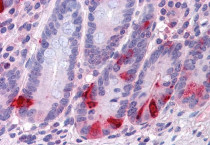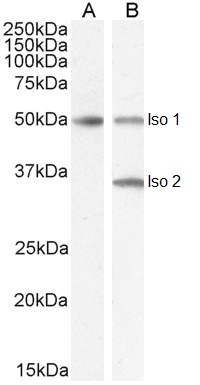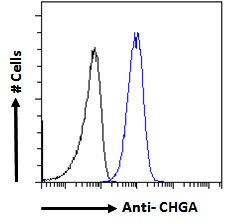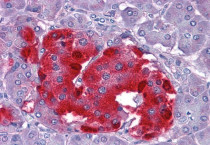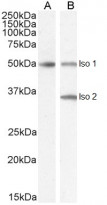anti-Chromogranin A precursor antibody
| 产品描述 | Goat Polyclonal antibody recognizes Chromogranin A precursor |
|---|---|
| 反应物种 | Hu |
| 应用 | FACS, IHC-P, WB |
| 宿主 | Goat |
| 克隆 | Polyclonal |
| 同位型 | IgG |
| 靶点名称 | Chromogranin A precursor |
| 抗原物种 | Human |
| 抗原 | C-QGAKERAHQQKKH |
| 偶联标记 | Un-conjugated |
| 別名 | Vasostatin II; CGA; Vasostatin I; Pituitary secretory protein I; SP-I; CgA; SL21; Chromogranin-A |
| 应用建议 |
| ||||||||
|---|---|---|---|---|---|---|---|---|---|
| 应用说明 | WB: Recommend incubate at RT for 1h. IHC-P: Antigen Retrieval: Steam tissue section in Citrate buffer (pH 6.0). * The dilutions indicate recommended starting dilutions and the optimal dilutions or concentrations should be determined by the scientist. |
| 形式 | Liquid |
|---|---|
| 纯化 | Purified from goat serum by ammonium sulphate precipitation followed by antigen affinity chromatography using the immunizing peptide. |
| 缓冲液 | Tris saline (pH 7.3), 0.02% Sodium azide and 0.5% BSA |
| 抗菌剂 | 0.02% Sodium azide |
| 稳定剂 | 0.5% BSA |
| 浓度 | 0.5 mg/ml |
| 存放说明 | For continuous use, store undiluted antibody at 2-8°C for up to a week. For long-term storage, aliquot and store at -20°C or below. Storage in frost free freezers is not recommended. Avoid repeated freeze/thaw cycles. Suggest spin the vial prior to opening. The antibody solution should be gently mixed before use. |
| 注意事项 | For laboratory research only, not for drug, diagnostic or other use. |
| 数据库连接 | |
|---|---|
| 背景介绍 | The protein encoded by this gene is a member of the chromogranin/secretogranin family of neuroendocrine secretory proteins. It is found in secretory vesicles of neurons and endocrine cells. This gene product is a precursor to three biologically active peptides; vasostatin, pancreastatin, and parastatin. These peptides act as autocrine or paracrine negative modulators of the neuroendocrine system. Other peptides, including chromostatin, beta-granin, WE-14 and GE-25, are also derived from the full-length protein. However, biological activities for these molecules have not been shown. [provided by RefSeq, Jul 2008] |
| 研究领域 | Cancer antibody; Controls and Markers antibody; Neuroscience antibody; Signaling Transduction antibody |
| 预测分子量 | 51 kDa |
| 翻译后修饰 | Sulfated on tyrosine residues and/or contains sulfated glycans. O-glycosylated with core 1 or possibly core 8 glycans. Proteolytic processing gives rise to an additional longer form of catestatin (residues 358-390) which displays a less potent catecholamine release-inhibitory activity (PubMed:10781584). Plasmin-mediated proteolytic processing can give rise to additional shorter and longer forms of catestatin peptides (PubMed:17991725). |
ARG63979 anti-Chromogranin A precursor antibody WB image
Western Blot: human kidney lysate (35 µg protein in RIPA buffer) stained with ARG63979 anti-Chromogranin A precursor antibody at 0.1 µg/ml dilution.
ARG63979 anti-Chromogranin A precursor antibody IHC-P image
Immunohistochemistry: Paraffin-embedded Human pancreas tissue. Antigen Retrieval: Steam tissue section in Citrate buffer (pH 6.0). The tissue section was stained with ARG63979 anti-Chromogranin A precursor antibody at 3.75 µg/ml dilution followed by AP-staining.
ARG63979 anti-Chromogranin A precursor antibody WB image
Western blot: 35 µg of Human brain lysate (A) and isoform 1+2 (B) (in RIPA buffer) stained with ARG63979 anti-Chromogranin A precursor antibody at 2 µg/ml dilution and incubated at RT for 1 hour.
ARG63979 anti-Chromogranin A precursor antibody FACS image
Flow Cytometry: Paraformaldehyde-fixed A549 cells permeabilized with 0.5% Triton. Cells were stained with ARG63979 anti-Chromogranin A precursor antibody (blue line) at 10 µg/ml dilution for 1 hour, followed by incubation with Alexa FluorR 488 labelled secondary antibody. IgG control: Unimmunized goat IgG (black line).
ARG63979 anti-Chromogranin A precursor antibody IHC-P image
Immunohistochemistry: Paraffin-embedded Human small intestine tissue. Antigen Retrieval: Steam tissue section in Citrate buffer (pH 6.0). The tissue section was stained with ARG63979 anti-Chromogranin A precursor antibody at 3.75 µg/ml dilution followed by AP-staining.
 New Products
New Products




